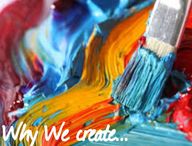
Return to flip book view
Why We create...
People create art in many different ways and for many different reasons; reasons that are as varied as the artists themselves. Some of those reasons include:
historical documentation commemoration of an event calling attention to big ideas or themes making statements of protest expressing religious or cultural values or simply creating objects of beauty
Greek / Roman
Looking back through history we can learn much about what life was like for many different groups of people around the world by examining their art objects and artifacts. Records of previous civilizations are usually to be found in their arts.
We know what went on in Greek and Roman times because we have their art and artifacts available to us for study.
You can visit this page to learn some more information about Greek and Roman art.
Athenian black-figure amphora, showing olive gathering, c.520 BC (ceramic), Greek, (6th century BC) / British Museum, London, UK, / The Bridgeman Art Library
Other Cultures
Art is a reflection of culture and can be created to express cultural values or habits of mind, and to reinforce or support cultural activities (ceremonial clothing, images of icons, headdresses and sculptures).
Ancestor mask, c. 1980, Paua, New Guinea. Wood, grass and shells. Gallery of Tribal Art, Vancouver, British Columbia, Canada.
Historical Events...
When most of the population in Europe was illiterate art was used to record and remember important events in history. The Bayeux Tapestry tells of the events leading up to the Norman conquest of England. Read the tale of the tapestry here, and see close ups of the sections here .
Before cameras were available it was the portrait artist who depicted the life and times of people who lived before, including themselves. Learn more about these two pictures here and here.
Fragment of the Bayeux tapestry, 1075-1080, Wool embroidery on linen, 20” (51cm)x230’(70m)
Recording Memories...
Many artists draw upon their skills to record memories or events from their own personal histories, or in the history of the larger community to which they belong.
Learn more about Andrew Wyeth and who this person in the painting on the right is here.
Monuments...
Monuments created by artists celebrate a nation and its national identity, Or mourn the loss of its fallen.
Universal Themes...
Artists explore universal themes such as family, the human condition, conflict or peace, and reflect back ideas, values, and feelings that are important to individuals and societies; courage, love sadness hope happiness, the struggle to endure, to name a few. Rockwell, Turner, and Chagall painted these pictures
Themes...
Käthe Kollwitz showed through her art the horror of war and the desperation of people living under political oppression; George Bellows showed the excitement of a prize fight in the 1920’s.
Albert Bierstadt, Among The Sierra Nevada Mountains California, 1868, oil on canvas, 120in wide x 72in high, National Museum of American Art, Smithsonian Institution
Learn more about painters of the American West here.
What is...
Marcel Duchamp, Christo and Jean-Claude, and Andy Warhol all asked, “what is art?”
Fun and Challenge...
Alexander Calder experienced the joy of creating for fun, and became one of the most innovative artists of our time. See more work here.
While Richard Anuszkiewicz challenged our visual perception with op art.
See more examples here, or here.
Finally...
Cathcart, Fantauzzi and Van Elslander bring us into post modernism and art used for social activism.
As you can see, art and the process of creating it have become a universal language that serves many different functions, limited only by the imagination of the artist.